The Monumental Fountain
 For years Pian di Nave, what we now know as "Giardini Vittorio Veneto", was a place full of more or less illegal constructions, numerous warehouses one next to the other, used as fishermen's warehouses, craft workshops or generally dilapidated dwellings.
For years Pian di Nave, what we now know as "Giardini Vittorio Veneto", was a place full of more or less illegal constructions, numerous warehouses one next to the other, used as fishermen's warehouses, craft workshops or generally dilapidated dwellings.
In 1936, Podestà Guidi's administration, with the aim of providing a visual outlet to the sea for the Corso Umberto I (now Corso Mombello) under construction, purchased several buildings, as well as the state-owned areas to the west of the Fortress, up to the area near the beginning of today's Lungomare Italo Calvino, and carried out a global reclamation, creating, according to plan, a large space to improve the landscape of the area. 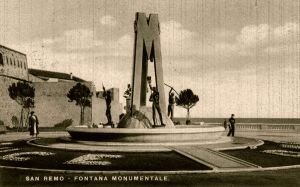 The first work was the construction of a retaining wall for the new square and consolidation work on the sea, so that it would no longer be threatened by storm surges.
The first work was the construction of a retaining wall for the new square and consolidation work on the sea, so that it would no longer be threatened by storm surges.
In addition, an environmental improvement was made with the creation of scattered flowerbeds, a variety of vegetation and even a pine forest. 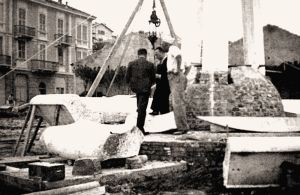 But what was most beautiful and impressive was the construction of a large and artistic monumental fountain. Also known as the "Fontana Luminosa", it stood in the centre of the square.
But what was most beautiful and impressive was the construction of a large and artistic monumental fountain. Also known as the "Fontana Luminosa", it stood in the centre of the square.
The work of the sculptor Giovanni Prini, it was built in the typical architectural style of the twenty-year period.
It is symbolised by an enormous "M" (Mussolini) in the centre of the fountain itself, surrounded by bronze statues of warriors. On either side were also 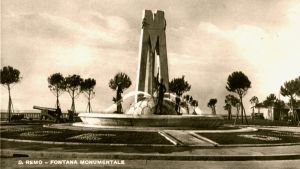 placed two of the cannons used by Admiral Pinelli to keep the city at bay when it rebelled against Genoa in 1753.
placed two of the cannons used by Admiral Pinelli to keep the city at bay when it rebelled against Genoa in 1753.
The inauguration ceremony was held on 4 November 1937 in the presence of the Hon. Tassinari, Undersecretary for Agriculture.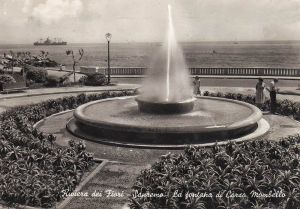 The history of this fountain was a troubled one, with continuous changes in its shape, until it disappeared altogether with the most recent restructuring of the landscape aspect of the entire square.
The history of this fountain was a troubled one, with continuous changes in its shape, until it disappeared altogether with the most recent restructuring of the landscape aspect of the entire square.
First of all, in the post-war period, in the name of reconstruction and above all to erase the legacies of the twenty years just gone, the "M" was demolished 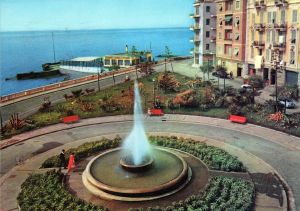 and the fountain became part of the overall reorganisation of the gardens, with flowerbeds, stony decorations, agave plants and others, and on display, alongside, the two eighteenth-century cannons recovered from the Fort in front of it.
and the fountain became part of the overall reorganisation of the gardens, with flowerbeds, stony decorations, agave plants and others, and on display, alongside, the two eighteenth-century cannons recovered from the Fort in front of it.
These pieces, after wandering here and there with different functions and for a long time even being forgotten, are now still on display at the sides of the facade of the Fort of Santa Tecla.
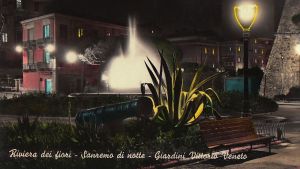
Although its appearance changed, it always remained a reference point for those who wanted to take a walk along the seafront and, above all, it remained "bright" and easily identifiable at night.




